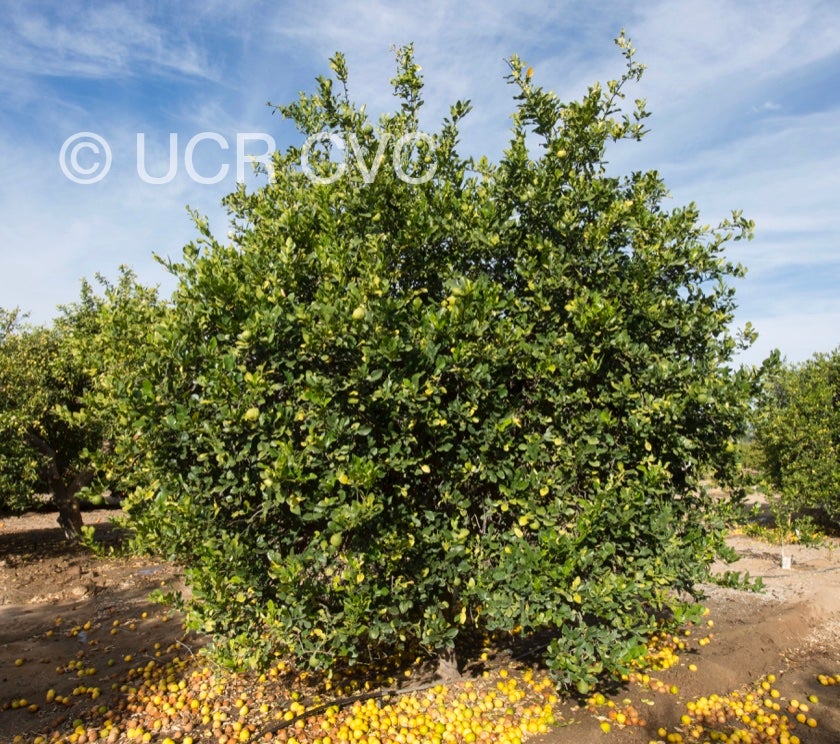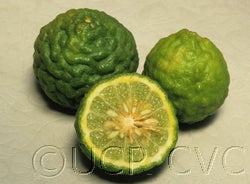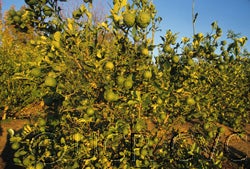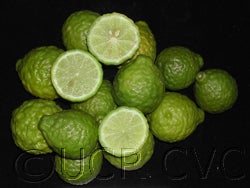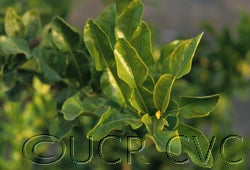Citrus hystrix DC.
CRC 2454
PI 539248
VI 463
Other names used: kafir lime, caffre lime, kieffer lime, kuffre lime, makrut, magrood, lima, leech-lime
“Kaffir” means infidel in Arabic, from “kafara”. G. C. Whitworth’s Anglo-Indian Dictionary (1885) states that not only was the term applied by Muslims to unbelievers, but “in Western India the word is a common term of abuse.” When Arab slavers first came to the east coast of Africa they applied the word to the inhabitants, and it is best known today as a derogatory term used by South African whites for blacks. According to A Dictionary of South African English (Oxford, 1991) this “term of contempt” is “now an actionable insult.” Indian Muslims most likely encountered the fruit as an import from lands such as Thailand and Sri Lanka, where Buddhists and other non-Muslims predominated. From this Indian usage, intended to convey otherness and exotic provenance, the term passed into English.
Source
Received as a live plant from the Office of Crop Physiology and Breeding Investigations
Washington, District of Columbia, 1930.
Parentage/origins
Parents unknown. From Ceylon.
Rootstocks of accession
CRC 1449 Citremon, Yuma Ponderosa lemon
Season of ripeness at Riverside
Citrus hystrix is used primarily for its leaves and so it can be considered year-round. When the fruit reaches full maturity in late winter to early spring, the rind turns yellow and the fruit falls from the tree.
Notes and observations
WPB: This is true hystrix.
11/13/87, EMN: This accession and CRC 3103 are very similar but are not alike. This accession matures earlier and is full of seed.
OJB: The tree is small and shrubby with distinctive leaves that have a petiole almost as large and wide as the leaf blade. It is these pungent leaves and not the fruit of this species that is commonly used in Thai and Indonesian cooking. The fruit is small, oval to short pyriform, and has an irregularly bumpy rind. In some places the fruit is used to make a shampoo that is insect repelling.
Description from The Citrus Industry Vol. 1 (1967)
"Citrus hystrix
Type.—Montpellier (De Candolle). Herb. Delessert, Geneva, Switzerland (fide Tanaka, 1931b, p. 11).
Distribution.—East Indian Archipelago, Ceylon, Burma, Malay Peninsula, Philippines; widely naturalized, native habitat uncertain.
Common name.—Mauritius papeda.
J. J. Ochse (1931, pp. 117-18) gave the following description of C. hystrix as it occurs in the Dutch East Indies (now Indonesia): "Low tree or shrub, 2-12 m high; trunk crooked, asymmetric or angular, rather thin, branched near the base; crown irregular, densely branched; branchlets thin, when young compressed-acutangular, when older terete, dark green, glabrous with scattered glandular dots, armed with axillary spines; spines short, stiff, subulate, green with hard brown or orange-coloured tips, obliquely erect, solitary, glabrous, 0.2-1 cm long. Leaves alternate or biseriate, stalked unifoliate, orbicular-ovate or ovate-oblong, lanceolate; base cuneate, obtuse or rounded, rarely subcordate, apex obtuse, rounded or obtusely acuminate, often notched; patently serrate-crenate, coriaceous, glabrous on both surfaces, above dark green, shining, beneath light green or yellowish-green, dull, densely pellucid dotted, fragrant when bruised, 3-15 cm long, 2.5-6 cm wide. Petiole from 0.3-0.5 cm above the base upwards with large, foliaceous wings; the winged part obovate or obcordate-oblong, with an acute, cuneote, obtuse or rounded base and an obtuse, truncate, rounded or slightly emarginate apex, patently crenate-exsculptate, coriaceous, above dark green, shining, beneath light green or yellowish green, dull, with scattered pellucid dots, including the wings 1-8 cm long, 1-4.5 cm wide, sometimes very similar to the leaf itself and not rarely for a greater or smaller part connate with it. Inflorescences axillary or terminal, dense, 1-5-flowered, glabrous. Flowers smallish, shortly stalked, 4-5-merous, fragrant, in bud globose, white, 0.5-0.7 cm diam.; pedicel terete, yellowish green, glabrous, 0.1-0.5 cm long. Calyx cupular, afterwards flat, 4-lobed, glabrous within and without, 0.2-0.35 cm diam.; lobes broadly ovate-triangular, acute or shortly acuminate, yellowish white with violet margins, ciliate, ±0.1 cm long. Petals 4-5, ovate oblong, with a narrowed base and a narrowed or acuminate, obtuse apex, yellowish white or tinged with red, glabrous, with scattered pellucid dots, 0.7-1 cm long, 0.3-0.5 cm broad. Stamens 24-30, quite free, 0.4-0.8 cm long, filaments thickened above the base, with a filiform apex, glabrous, 0.3-0.6 cm long; anthers elliptic-oblong, 0.15-0.25 cm long. Ovary depressed globose, glabrous, with a tuberculate-folded surface, 0.2-0.4 cm diam.; style short, robust, terete, glabrous, 0.1-0.15 cm long; stigma depressed globose, glabrous. Fruit pendulous, globose, ovoid or ellipsoid, with an abruptly contracted obtuse or rounded base and a rounded or slightly depressed apex, crowned by a short style-rest, very irregularly bumpy, glabrous, with many scattered glandular dots, when ripe yellow or yellowish green, feebly shining, 5-7 cm diam.; peel thick, its exterior layer of ±0.2 cm thickness, yellowish green, the inner part white; pulp yellowish green, very sour and slightly bitter, faintly fragrant; fruiting pedicel very short, 0.3-0.5 cm long. Seeds ovoid-oblong, 1-1.5 cm long, 0.5 cm thick; cotyledons and plumule white."
Ochse stated that "this species, called Djerook pooroot in the Dutch East Indies, is nowhere cultivated on a large scale but…very often on a small one."
This much misunderstood species was named by De Candolle from young seedlings, not yet in flower, grown from seed sent to the Montpellier Botanic Garden from Mauritius, where it was probably not native. De Candolle redescribed it in 1824 but had not yet seen flowers or fruits.
Thanks to flowering material from Mauritius and from Montpellier preserved in the Kew Herbarium, it is possible to determine with certainty that C. hystrix is the species with very bumpy fruits belonging to the subgenus Papeda that is widely distributed in Indonesia. The fruits usually have 10 to 12 segments (rarely 13 or 14). The leaves are blunt-pointed, usually of medium size, 8 to 12 by 3 to 5 cm, more or less irregular at the tip and sometimes slightly emarginate. The margins are more or less crenate. The winged petiole, usually two-thirds to three-fourths as long as the leaf blade, is broadly rounded and blunt at the base, often subtruncate at the tip, often with more or less crenate margins.
The flowers are small, with short, entirely free stamens, as in all the other species in the section Papeda. The fruits are almost always bumpy or tuberculate. The pulp-vesicles were first described by Penzig (1887, pp. 131-32), who stated: "They are provided with a slender very long stalk which suddenly enlarges toward the free end, forming a small round or oval body pointed at the tip." Penzig noted that they differ from the pulp-vesicles of the other species studied by him in showing "a large amount of oil accumulated in their centers." This accumulation of numerous droplets of oil, often of a very strong and acrid flavor, is characteristic of all the species of the subgenus Papeda. The cotyledons are epigeous in germination.
Citrus hystrix, although the best known and most widely distributed species of this subgenus, is not the most vigorous species, and not the most promising for use as a rootstock. It has undoubtedly hybridized with other species of the subgenus Papeda in the village fruit gardens of the people of the East Indian Archipelago and also with species of the subgenus Citrus. Doubtless some of these hybrids are included among the bizarre forms described and figured by Wester (1913 and 1915).
Bonavia reported (1886, p. 215) that the fruit of C. hystrix is never eaten; however, it is used by the natives in Ceylon as an insecticide for washing the head and also for smearing on the feet to kill land leeches. The tree is often cultivated near the villages for these purposes. According to Bonavia, C. hystrix may have come into Ceylon with the Dutch and their Malay servants for use as a hair wash. This use may account for the wide distribution of the species throughout the East Indian Archipelago and adjoining parts of the Asiatic mainland.
Availability
Commercially available in California through the Citrus Clonal Protection Program. Click here to order budwood.
USDA Germplasm Resources Information Network page for Citrus hystrix (CRC 2454)
Bibliography
"The Cultivated Oranges, Lemons Etc. Of India And Ceylon with researches into their origin and the derivation of their names, and other useful information", E. Bonavia, published in London in 1888 by W.H. Allen & Co, pages 81-82. Plate 225(CCXXV)
"Classification of Citrus Fruits of Assam", S.C. Bhattacharya and S. Dutta, published in India in 1956 by The Government of India Press, pages 87-88.
"Flora of Bristish India", J.D. Hooker, published in 1872, Volume 1, page 515-516
